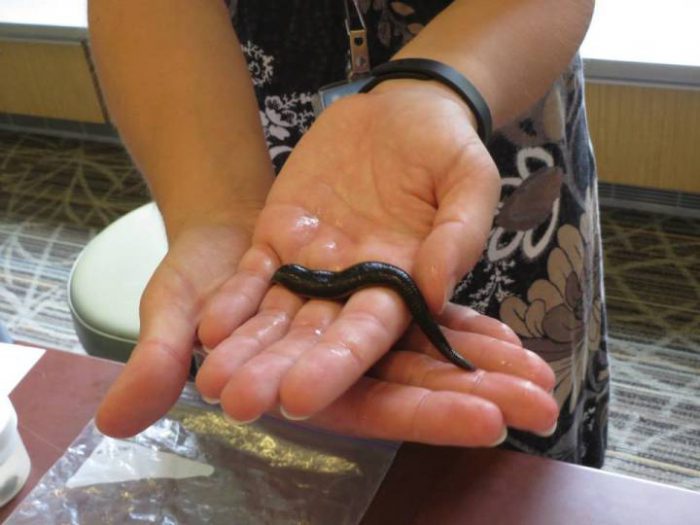Adorable? Really? A leech?
True, we might be overselling that point a bit. We'll come back to that one. First, let's get to the hard facts.
Macrobdella mimicus is a newly discovered species of North American medicinal leech — the first one found in over 40 years. It was found in southern Maryland, U.S.A. — very close to the Smithsonian Museum of Natural History, which is where researcher Anna Phillips works. In a Smithsonian Magazine post, she describes discovering them while collecting leeches in swamp water by allowing them to attach to her legs. (And if you know of a better way to collect leeches, Anna would love to hear about it.)
Anyway, this seems like a good time to talk about what the term "medicinal leech" means. Leeches attach themselves to an animal, feed on a little of its blood, then drop off. A medicinal leech is kind of a fancy way of saying that these blood-sucking little worms are happy to feed on human blood. As Anna clearly knows.
But the word "medicinal" isn't there by accident. It contains real truth!
The miracle leech
A handful of medicinal leeches. (Getty Embed)
Leech therapy is used today in patients in micro-surgery to repair skin, or reattach body parts such as ears, lips, or fingers. (We know... yikes! But it does happen.) The leeches actually are able to stimulate (or encourage) necessary blood flow, reduce inflammation (swelling), and anesthetize (or reduce pain).
In short, it allows the reattached part to heal properly and makes the whole procedure more comfortable for the patient. Incredible, really. It's all thanks to the properties of a leech's saliva. Its saliva is designed to allow blood to flow smoothly and relatively painlessly from the animal. And surgeons are able to put that talent to good use.
Meet Macrobdella mimicus
Of course, painless isn't exactly the first thing you think about when you hear that M. mimicus has three jaws and a total of about 200 tiny teeth. It's also uber squirmy and dark green and you know... a parasitic worm. So what was that we were saying about this one being adorable?
We suppose it all comes down to the fact that we couldn't help but be fascinated by this video the Smithsonian tweeted out about it. I mean, in the end, this is one neat little creature, capable of things that even modern medicine finds it hard to improve on. Why not press play below and meet it for yourself?
For #NationalRelaxationDay we share this hypnotic video...of a LEECH. Its name is Macrobdella mimicus. And it was just described today in the Journal of Parasitology, by our curator of parasitic worms, Anna Phillips @Annalida500, and a team of scientists. pic.twitter.com/3iCQO9h2Uk
— Smithsonian's NMNH (@NMNH) August 15, 2019
 Smithsonian researcher holds M. mimicus, a brand new leech species. (Smithsonian Museum of Natural History)
Smithsonian researcher holds M. mimicus, a brand new leech species. (Smithsonian Museum of Natural History)










Why is it so cute???????? ❓
😐 this makes me feel sick even though they are helpful